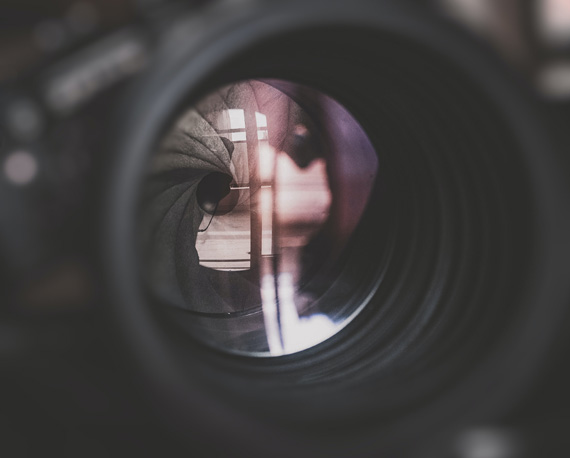We all use cameras in our day to day lives. However, most of us know nothing more about the devices than “point and shoot”. If you ever wondered how to take portrait photos of a subject with a blurred background, or how they take those pictures of trailing lights or water across a landscape, keep reading.
Light. We see it every day, and just like how we see light, a camera does the same thing. In dim light, our pupils dilate to bring in more light, so we can see better. In bright light, our pupils contract to restrict the amount of light so we can see without being blinded.

Photo by eberhard grossgasteiger
A camera will do this same thing. The aperture of a lens is the opening at which light passes through. For most lenses, this opening can change based on the camera’s settings. These opening have been standardized into specific sizes, called aperture stops, or F-stops.
If you’ve ever bought an SLR camera, then you may have seen the F-stop numbers and not know what it meant. You may have seen it represented like so: f/2.8 – f/5.6. This means that this lens makes a range of openings from the 2.8 stop to the 5.6 stop. Just what does it all mean?
Follow me closely: The larger the F-stop number is, the smaller the opening is. In other words, the larger number represents the lower end of the scale, less light entering the camera. A smaller F-stop number means the opening is larger, more light entering the camera.
Photo by Deraman Uskratzt; ISO 400, f/1.8, 1/1250-second exposure.
Aperture goes hand and hand with the shutter. The shutter is what lets light hit the film (or digital receiver). Remember, the aperture controls how much light enters, and the shutter lets that light hit the film.
Shutter speed is simply the length of time that the shutter remains open to let light hit the film. It is directly dependent on the aperture and the F-stop, because the amount of light entering the camera through the aperture determines how long the shutter remains open. With each F-stop, the shutter speed will increase or decrease in step. Naturally, a larger F-stop number (remember, smaller opening), requires a slower shutter speed. A smaller opening means less light is reaching the film, so it needs more time to create a picture or exposure.
A smaller F-stop number (remember, larger opening), requires a faster shutter speed. Less time is needed to create the exposure.
Opening and closing a shutter is like opening and closing your eyes. If you open and close your eyes quickly, you can not see very much, and only what’s immediately in front of you may be in focus. However, if you leave your eyes open, much more may be in focus. This same principle applies to- you guessed it, the F-stop. How much of what’s in front of you that’s in focus is called depth of field.
A smaller F-stop will have a faster shutter speed, thus it would have less of a depth of field than a larger F-stop. This means that smaller F-stops (larger opening) are great for portraits, where the main subject of the photo is a person. By the same coin, larger F-stops (smaller opening) are great for landscape shots, where there is huge landscape that is the main subject.
So how to we go about making special effects?
Let’s say, for example, we want to make a car or a fast moving person appear to be frozen in time, with no blur. We would want a quick shutter speed, because a slow shutter speed would capture too much light, essentially capturing too much in time, blurring the shot. A quick shutter speed would also mean a smaller F-stop. This would also mean that we have a diminished depth of field. Bottom line: Quick shutter speed = smaller F-stop number = more light being let in (larger opening) = less in focus (smaller depth of field) = frozen time, focused subject, blurred background.
Photo by georgemoga; ISO 100, f/4.0, 5-second exposure.
Let’s say we see a fountain. We want to show the water as moving and flowing. If we take a picture with the settings in the previous example, we would see droplets of water frozen in time. We want to show movement, and encourage blur in the water. So what do we do?
To begin on this example, we have to know what causes blur. We already know depth of field blur, but what about motion blur? When the camera opens it’s shutter, it makes a permanent impression on the film (or digital receiver). If the shutter is held open too long and the subject moves or the camera moves, this shows on the film as blur, almost like smudging a painting. So rest assured, when a photo is blurred, the camera is functioning as intended!
For this photo, the only thing moving should be the water. Any slight movements of the camera will ruin the whole effect. The F-stop would need to be a high number, which would mean the shutter is left open longer because there is less light reaching the film. More of the picture would be in focus as well. Slow shutter speed = larger F-stop number = less light being let in (smaller opening) = more in focus (larger depth of field) = illusion of movement at higher F-stops, focused subject, focused background.
About the Author:
Chris Sawyer, aka “Zacarias” runs a technology based discussion board, hi! Technotic discussion boards.
Go to full article: Aperture and Shutter: Science of the F-stop
What are your thoughts on this article? Join the discussion on Facebook
PictureCorrect subscribers can also learn more today with our #1 bestseller: The Photography Tutorial eBook
The post Aperture and Shutter: Science of the F-stop appeared first on PictureCorrect.
from PictureCorrect https://ift.tt/2pKmaJs
via IFTTT






0 kommenttia:
Lähetä kommentti